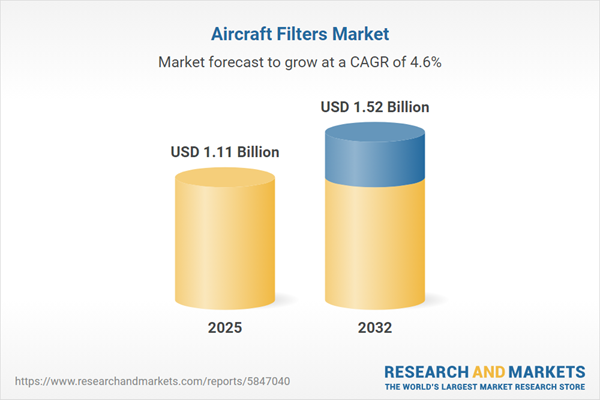Speak directly to the analyst to clarify any post sales queries you may have.
The aircraft filters market is undergoing significant transformation as aviation leaders confront evolving compliance standards and accelerate the adoption of integrated digital solutions. As operational demands shift and supplier relationships adapt, senior executives must steer procurement and innovation strategies with agility and foresight.
Market Snapshot: Aircraft Filters Market Size and Trends
The global aircraft filters market continues to advance steadily, with size estimates highlighting enduring growth and resilience. Innovation in filter materials, coupled with advancements in smart monitoring, is strengthening engine performance and optimizing air quality while directly supporting compliance with new emissions standards. This sector’s evolution reflects a broader move toward digitally enabled maintenance ecosystems and heightens the importance of supplier collaboration for uninterrupted fleet operations. As airlines and manufacturers aim for improved operational continuity, ongoing technology integration and transformation in procurement priorities remain vital to sustaining market competitiveness.
Scope & Segmentation: Comprehensive Market Intelligence
This report delivers detailed intelligence for senior executives across every key facet of the aircraft filters market, empowering strategic decisions in procurement, technology deployment, and operational planning. Coverage includes:
- Filter Types: Air intake, cabin air, fuel, hydraulic, and oil filters, each performing a critical role in system safety and reliability.
- Aircraft Types: Commercial jets, general aviation, helicopters, and military platforms, each presenting specialized filtration and performance considerations.
- End Users: Original equipment manufacturers, aftermarket suppliers, MRO providers, and digital sales platforms—contributing across the aviation filtration lifecycle.
- Distribution Channels: Direct sales, service networks, and global partners—facilitating timely and effective delivery to maintain fleet readiness.
- Technologies: Metal-based, multi-stage, paper, and synthetic filters—driving improvements in longevity, compliance, and sustainability across various operational environments.
- Regions: Americas, Europe, Middle East & Africa, and Asia-Pacific, where local infrastructure, procurement practices, and regulatory trends influence market development and commercial opportunities.
- Leading Companies: In-depth profiles and analysis of Donaldson Company, Parker-Hannifin Corporation, Danaher Corporation, Mann+Hummel GmbH, Filtration Group, Cummins, Eaton, Freudenberg, Honeywell International, Meggitt, Porvair, Recco Products, Champion Aerospace, Purolator Facet, and Safran Filtration Systems, with insights into strategic partnerships and innovation pipelines.
Key Takeaways for Senior Decision-Makers
- Intelligent, data-driven maintenance platforms now enable aviation companies to identify filter performance issues earlier, allowing for reduced operational downtime and extended service intervals.
- Evolving regulatory standards are prompting sustained investments in advanced filtration technology to help safeguard compliance and preserve access to international markets.
- Procurement strategies increasingly emphasize supply chain transparency and rapid responsiveness, supporting reliable fleet operation even as economic conditions fluctuate.
- The integration of digital procurement and online sales tools is increasing the speed and adaptability of collaboration between manufacturers and MRO providers across all market segments.
- Regional differences drive unique requirements: North America stresses reliability and system resilience, Europe prioritizes environmental sustainability, Asia-Pacific focuses on meeting higher production demands, and the Middle East & Africa promote growth through local upskilling and partnership expansion.
Tariff Impact: U.S. Trade and Supply Chain Adaptation
Recent import tariffs on filtration products in the United States are introducing additional complexity and increased costs to aviation supply chains. Industry leaders are responding by expanding domestic manufacturing capacity, fortifying local operations, and forming strategic alliances with distributors. These actions support the creation of a more flexible and resilient supply network that can better withstand changes in global trade dynamics.
Methodology & Data Sources
This assessment relies on a robust combination of executive interviews, regulatory analysis, proprietary datasets, and reference to trusted market research authorities. The multi-source methodology ensures each insight is up to date and tailored for executive-level decision-making within the aviation sector.
Why This Report Matters
- Enables senior executives to benchmark filtration technology trends and assess compliance strategies in relation to global best practices for more informed, strategic planning.
- Clarifies how digital transformation and new material technologies are directly affecting operational management in complex regulatory environments.
- Equips leadership teams with actionable market intelligence to proactively address ongoing supply chain and technology challenges across established and emerging aviation markets.
Conclusion
This report provides senior aviation leaders with focused insights and guidance to align compliance, supply chain, and operational strategies for ongoing industry success. Informed, data-backed decisions will support resilience and enduring organizational advantage.
Additional Product Information:
- Purchase of this report includes 1 year online access with quarterly updates.
- This report can be updated on request. Please contact our Customer Experience team using the Ask a Question widget on our website.
Table of Contents
3. Executive Summary
4. Market Overview
7. Cumulative Impact of Artificial Intelligence 2025
Companies Mentioned
The companies profiled in this Aircraft Filters market report include:- Donaldson Company, Inc.
- Parker-Hannifin Corporation
- Danaher Corporation
- Mann+Hummel GmbH
- Filtration Group Corporation
- Cummins Inc.
- Eaton Corporation PLC
- Freudenberg SE
- Honeywell International Inc.
- Meggitt PLC
- Porvair PLC
- Recco Products Inc.
- Champion Aerospace LLC
- Purolator Facet Inc
- Safran Filtration Systems
Table Information
| Report Attribute | Details |
|---|---|
| No. of Pages | 199 |
| Published | November 2025 |
| Forecast Period | 2025 - 2032 |
| Estimated Market Value ( USD | $ 1.11 Billion |
| Forecasted Market Value ( USD | $ 1.52 Billion |
| Compound Annual Growth Rate | 4.5% |
| Regions Covered | Global |
| No. of Companies Mentioned | 16 |









